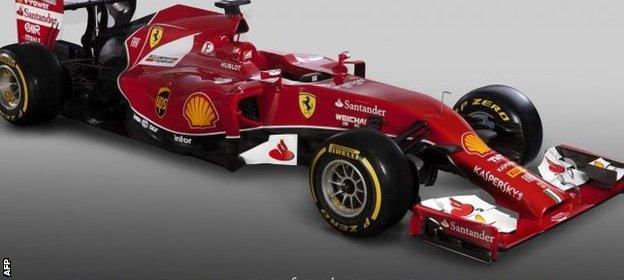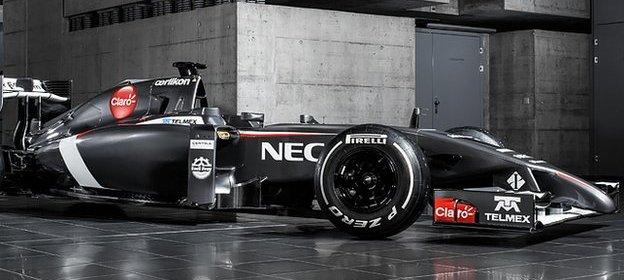F1 2014: All aboard the 'power train' - new rules explained
- Published
Formula 1 is introducing arguably the biggest set of rule changes in its history this season.
Most affected are the engines as the sport goes further than ever before to embrace 'green' technology.
But the appearance of the cars is changing, too.
Here, BBC Sport highlights the key things to look out for in 2014.
Engines, Ers and unreliability
First things first, the 2.4-litre naturally aspirated V8s, which have been in use since 2006, have been replaced by 1.6-litre V6 turbos.
After several years of a freeze on engine development, engine power will now be a performance differentiator again. And part of the new rules package is a fuel limit.
Drivers will now have to complete races on just 100kg - or about 130 litres - of fuel. That's down from the 150kg or so teams would use last year, when there was no limit. Meanwhile, engines must consume fuel at no more than 100kg per hour.
The fuel limit is not as draconian as it at first appears, though, so don't expect races to become an economy run.
The new engines don't use as much fuel for a start, while much more power is now available from the 'hybrid' technology, known as Ers.
Ers, which stands for 'energy recovery system', is made up of the Kers system that has been around for a while and a second electric motor fitted to the turbo.
The Kers system harnesses kinetic energy from the rear axle during braking via an electric motor to be stored in a battery pack reapply under acceleration. Last year, it was allowed to produce 60kw for up to 6.7 seconds a lap. This year, however, it can produce 150kw for 30 seconds.
Learn the physics behind a Formula 1 car
As for the second electric motor, that will harness energy from the turbo that would otherwise be wasted as heat.
The amount of energy that can be generated in this way is unlimited and can be either stored in the battery or used to accelerate.
This electric motor also increases the efficiency of the turbo and can be used to ensure it works the instant the driver applies the throttle.
In the past, turbo engines have always had a slight throttle lag - a delay in power while the turbo gets up to speed. This has been removed in these new engines.
Drivers pushed a button to access the power stored by the Kers system, but the new Ers will be controlled by the engine management computer, so it means there is less work for the drivers to do.
All sounds good, doesn't it? But there is a price to pay.
Such dramatic changes mean reliability will be a major concern, certainly at the start of the season.
Red Bull team principal Christian Horner has said he believes failure rates in races could be as high as 50%.
U.G.L.Y. spells radical redesign
In addition to the changes to the engines, there are a series of changes to the cars. The effect of these will be to make the cars look different this year, even ugly.
The front nose is the source of most concern.

The new Ferrari, which will be driven be Fernando Alonso and Kimi Raikkonen
It's been lowered by 415mm for safety reasons, to just 135mm above the floor of the car.
Coupled with a complicated set of dimensional requirements, this is likely to mean cars resemble a giant anteater. This has already been seen with the new Williams, the first team to reveal the complete look of their car.
Teams could improve the appearance of the car by using 'vanity panels' that would smooth the shape of the nose but these add weight so designers will be reluctant to use them extensively.
The idea behind the new nose was to increase safety in two ways.
It will reduce the danger in incidents of T-boning, when the nose of one car hits the side of another, by making it less likely that the high nose of a car can hit a driver. And it will prevent a car from being launched into the air when it hits the rear wheels of the one in front.
It is not just the front nose that has been targeted by the FIA, which governs F1. It has also lowered the front of a car's chassis for the same reason.
However, teams want the chassis as high as possible for the best under-car aerodynamics and front-suspension geometry.
The rules dictate that the chassis in front of the driver must be 625mm above the floor of the car, and that the height of the front of the chassis by his feet - the front bulkhead - must be 525mm. But they do not define a minimum distance for the transition between these two heights.
As a result, some teams have created a vertical 10cm wall immediately after the bulkhead, which might not be aesthetically pleasing to some, although there is always the option of using 'vanity panels' to cover the resulting 'step'.
The FIA is not happy about this, as it reduces the impact of its safety-related changes, and officials had been assured by designers no team would make the 10cm height change happen over as short a distance as some now have.
There are other changes, too, all of which will have a significant impact on aerodynamics.
The front wings have been narrowed by 150mm, the lower rear beam wing has been removed and the position of the exhaust has been moved.

Sauber's new car features the 'anteater' nose
The narrower front wings mean it will be more difficult for teams to turn airflow around the outside of the front tyres, which will affect the entire car's aerodynamic downforce.
The removal of the rear beam wing prevents teams joining up the different airstreams over the rear wing and through the car's floor, which will make rear aerodynamics more critical and reduce overall downforce.
Arguably most impactful, though, are the changes to the exhaust, which will end the 'exhaust-blown floors', which have been the defining technology of the last three years.
Using exhaust gases to boost downforce was put to great use by Red Bull and was one of the central reasons for their domination of recent years.
Mandating a single, central exhaust pipe, which exits above the gearbox, means the gases can no longer be harnessed in this way.
Check the small print...
These seismic technical changes are joined by a series of tweaks to the sporting rules.
Most controversial is the decision to award double points at the final race in an attempt to prevent championships being decided early.

Vettel celebrates his fourth World Championship
The proposal, dreamt up by F1 supremo Bernie Ecclestone, follows the recent dominance of Red Bull's Sebastian Vettel, who has won the last four drivers' titles.
The German claimed two of those last three championships with at least three races to go.
There has also been a tweak to the penalty system.
As well the introduction of a new five-second penalty for minor offences, points will be awarded on a sliding scale depending on the misdemeanour. Any driver who racks up 12 points in a calendar year will serve an automatic race ban.
It sounds dramatic, but no driver would have been banned had the new system been in place over the last few years - even Romain Grosjean and Pastor Maldonado, who both had incident-ridden seasons in 2012.
Less controversially, drivers will now choose their car number for their entire career, although number one is reserved for the reigning world champion, should he choose to use it.
- Published3 December 2013